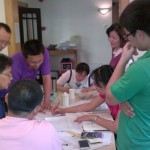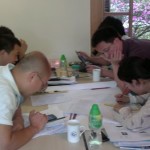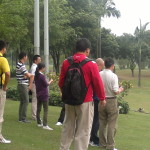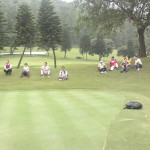Wednesday 20th March 2013
Today we had quite a long session. I’m sorry if it was quite dry material but I thought it was important to cover some basic turfgrass information.
Today’s material started with the factors that help us to make a visual appraisal of the health and/or suitability for golf of the turfgrass on the golf course. As always, we discovered that things aren’t as black and white as we would like as some very fine links courses have turf that is anything but uniform in appearance. Such is life!
We moved on to study some foundation material on the most important chemical and physical processes that go on within the soil such as the variability in soil pH (whether the soil is acid, neutral or alkaline).
Later we saw that soil texture is a measure of the relative amounts of sand, silt and clay particles within the soil and we discovered that a healthy rootzone is actually 50% nothing or at least useful space!
We found that the structure of soil results in the variable presence of Micro porosity (water space) and Macro porosity (air filled space) in the soil and the importance of this in keeping the soil sweet (not too acid) and in maintaining a suitable population of soil microbes which help to provide nutrition to the grass plants and keep thatch under control to some extent.
We had a good discussion on the merits or otherwise of aeration techniques and topdressing of golf greens. I shared some of my techniques from Scotland and Kasey shared her experiences from Nansha Golf Club which were very interesting for me to hear.
Finally we looked at the concept of warm and cool season plants and I think there was some surprise that over 90% of plants are cool season varieties.
Plants have to manufacture their own food by combining energy from the sun with nutrients and water from the soil in a very impressive process called photosynthesis. The realisation that some plants had adapted a more efficient method of doing this in very hot conditions led to the discovery of the warm season/cool season divide in the plant kingdom.
I want to spend a full day on this and related material on Saturday 23rd March including what goes on underground when plants extract water and nutrients from the soil.
I will also cover some material on what happens when turfgrass is left to its own devices without interference from “experts” like us!
So tomorrow (Thursday 21st) I want us to achieve 5 things:
1. I would like to prepare for Saturday’s work by finishing off some study on the functional qualities of turfgrass. This is essential to a good understanding of Saturday’s material.
2. I want to present you with some items to think about for your project related to today’s turfgrass study.
3. I would like to have a discussion on the format of your golf development projects and to give any assistance you need on moving on to the next stage with this.
4. I want to pass on a short ppt of slides to give you some ideas for the presentation of your master plans.
5. I want to allow you some time to consider your plan of action and maybe to start work on your master planning in the afternoon. I’ll be around to help answer any questions you might have.
Thank you to you all for arranging my visit to the Chinese Medicine Specialist; I think I can feel a real improvement in flexibility of my back already!
Thank you also to Professor Wu for taking me to the supermarket for much needed beer, chocolate and tea!
Finally I think we should go with your suggestion for everyone to get their copies of ppts from Sabrina’s computer due to internet speed. I’ll continue to post updates here anyway
Until tomorrow.
John
Install this web app on your Android: Tap menu, more options, and then Add Shortcut To Homescreen.
×






